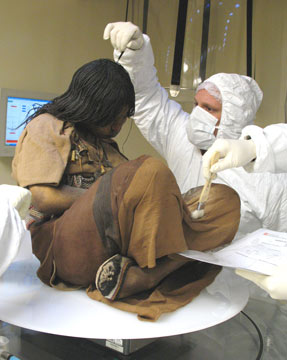|
NEWS NOTES
Geoarchaeology
Mummy hair tells gruesome story
 Copyright Museo de Arqueología de Alta Montaña |
| With funding from the Wellcome Trust, researchers analyzed hair from mummies, including the 15-year-old girl pictured here who is now on display in Argentina’s High Mountain Archaeological Museum, to learn more about the lives of Inca children who were ritually sacrificed. |
Few people ever witnessed the human sacrifice rituals performed by the Inca high on the snow-covered peaks of the Andes. Today, archaeologists have little direct evidence of these rituals, instead relying heavily on Spanish historical documents for clues. But now, researchers have turned to chemistry for another perspective. By studying stable isotopes in hair from mummies of sacrificed children, researchers have gained new insight into the final months of these children’s lives.
Before the arrival of the Spanish, the vast Inca Empire sprawled along the Andes from modern-day Ecuador to Chile. Over the past decade, archaeologists have discovered several mummies of sacrificed children in these mountains. The perfectly preserved tissues of these frozen bodies reveal details of their former lives such as their diet, says archaeological scientist Andrew Wilson of the University of Bradford in the United Kingdom, who led the new research. This information can help researchers learn more about who these children were and how they were prepared for sacrifice.
To retrieve these details, Wilson and colleagues studied stable isotopes that are recorded in the body’s tissues. For example, different ratios of carbon isotopes can reveal the type of plants one ate, while ratios of nitrogen isotopes indicate if protein in the diet came from plants or animals. Typically, researchers have measured these isotopes using bones or teeth, but studying hair was more advantageous in this case, Wilson says. Bone is constantly being reformed, he says, so its isotopic signature represents a lifetime average, and isotopes in teeth characterize early childhood. Hair, on the other hand, grows about one centimeter per month, thus keeping a running tally of changes in isotopes over time.
The team examined hair from four mummies, including hair from a 15-year-old girl known as the Llullaillaco Maiden, whose long hair documents the last two and a half years of her life. Her fate was sealed at least one year prior to death, Wilson says. At that point, her carbon and nitrogen isotopes demonstrate a major shift in diet, from one dominated by C3 plants such as potatoes, to one rich in maize and meat. This probably represents a change in social status, says study co-author Johan Reinhard, an explorer-in-residence at the National Geographic Society, who discovered the Maiden. A diet rich in tubers is indicative of a peasant, while maize and meat were foods of the elite. The change suggests the Maiden’s social standing improved, perhaps as a way to make her an appropriate sacrifice, the researchers wrote Oct. 16 in Proceedings of the National Academy of Sciences. At four and a half months prior to death, her isotopes undergo another change, suggesting she had begun her pilgrimage to northwestern Argentina’s 6,739-meter-tall Llullaillaco volcano. Coca metabolites in her hair suggest that she was drugged before reaching her final resting place in a shrine 25 meters from the mountain’s summit.
But the mummies don’t all tell the same story. “It’s not all black and white,” Reinhard says. “They don’t all fit one mold.” For example, the dietary changes recorded in the hair of a mummified girl discovered atop Peru’s Sara Sara volcano correlate with seasonal changes, suggesting that not all children necessarily received the same treatment in preparation for sacrifice.
This is a “very informative study,” says Niels Lynnerup of the University of Copenhagen. “The whole concept of reconstructing the last days, in terms of diet, for any archaeological find — sacrifice or not — has tremendous possibilities.”

 Subscribe
Subscribe


